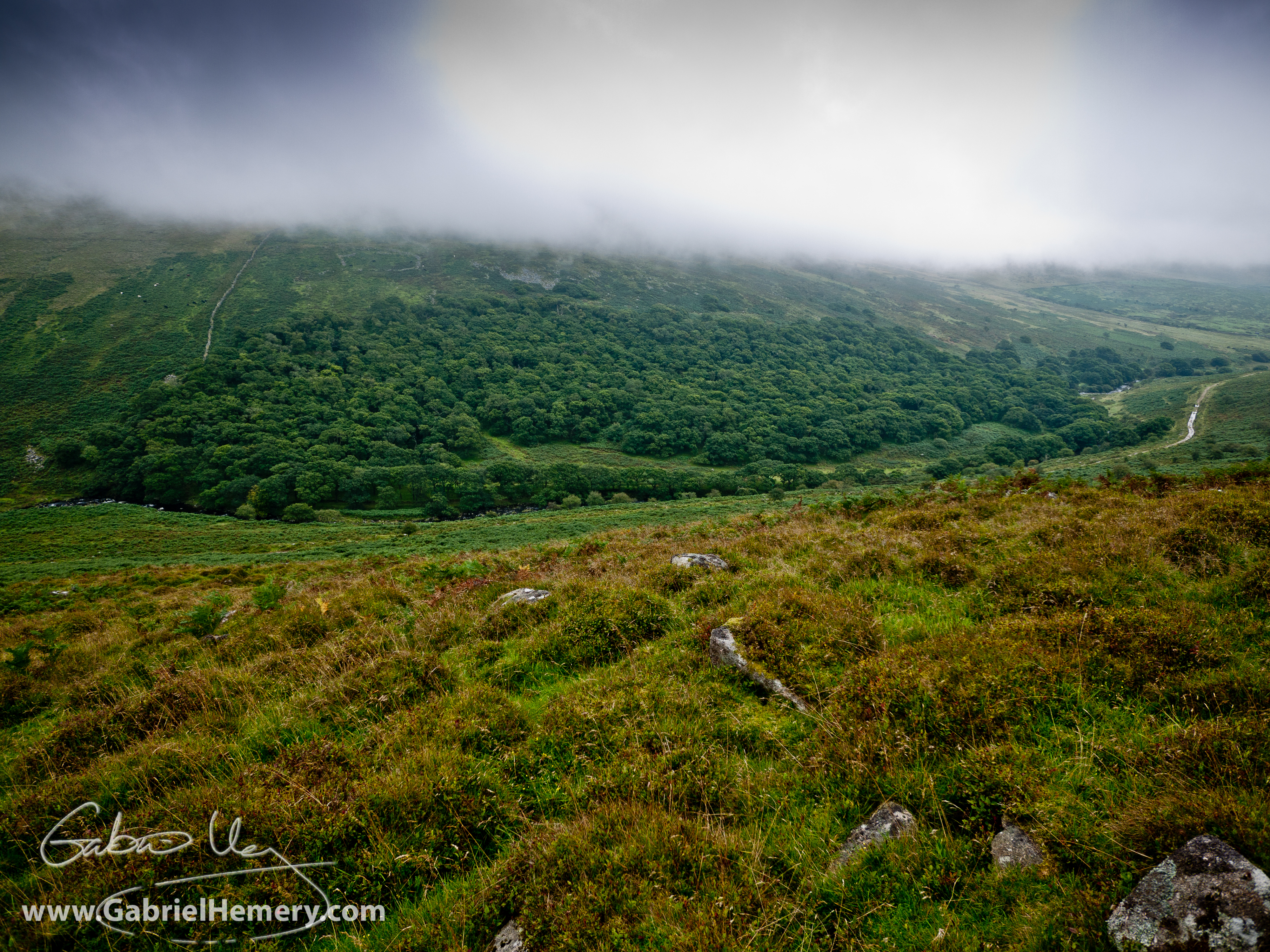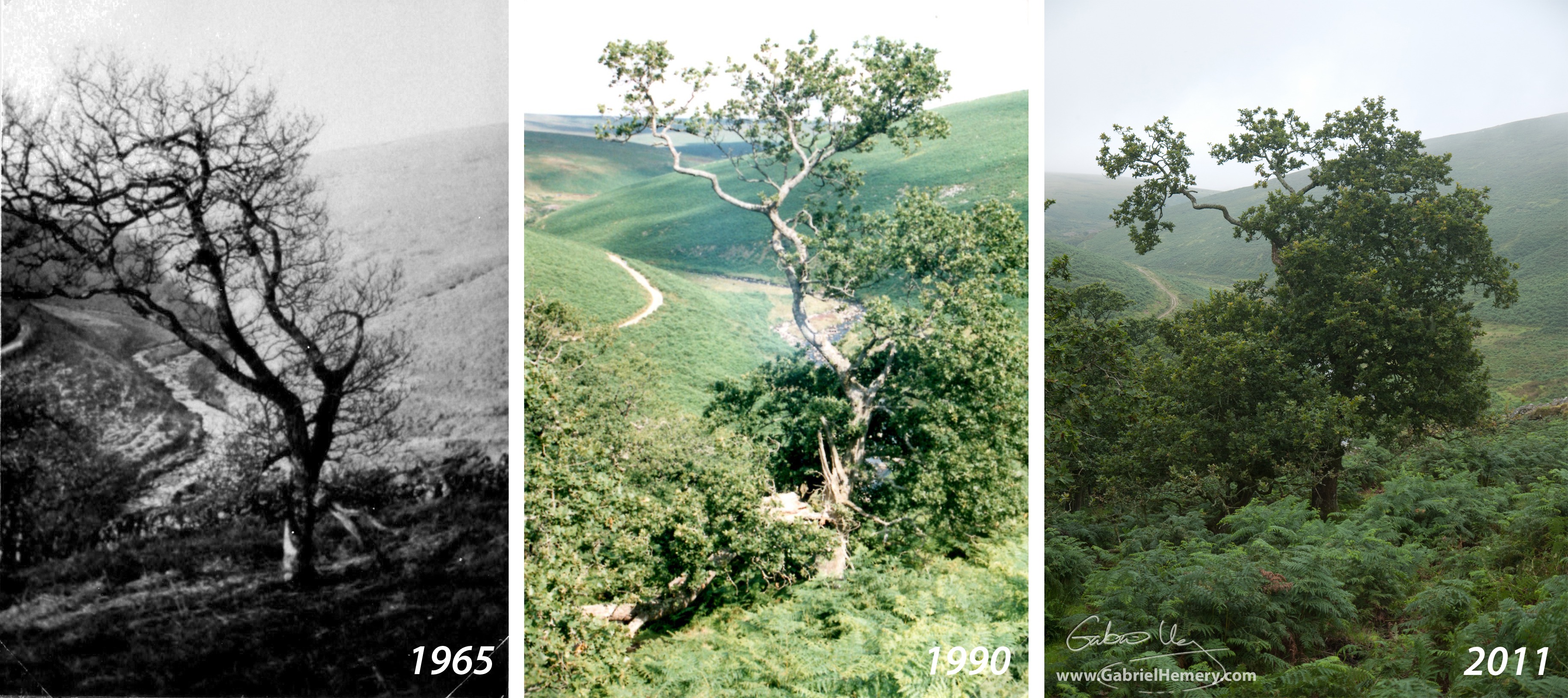High on the windswept and misty wild moorland of Dartmoor in south west England nestle three extreme oak woodlands. The most well-known is Wistman’s Wood, which has been the subject of numerous ecological studies. Less widely known are Black Tor Copse in the north of Dartmoor, and Piles Copse in the south.

I completed my Undergraduate dissertation studying the biogeography of Piles Copse. I realised that it was 20 years since this work and that I had not been back since. During a recent visit to Devon I made a return visit.
I set off for the short walk from the nearby village of Cornwood at dawn. Climbing first the domed mass of Stalldown Barrow, I followed the Bronze Age stonerow that leads to the summit. As is often the case with Dartmoor, visibility was very limited thanks to the famous mists (as a former member of the Dartmoor Mountain Rescue I have some great stories to tell!). The eerie silence was broken only by the “kew” of buzzard and “prkk-prkk” of raven until, as I descended the hill’s heather-clad Eastern flanks and over the distant babble of the River Erme, I began to hear woodland birds; so I knew that I was on target. Soon, Piles Copse appeared below the swirling mists.
Piles Copse
Britain has five high altitude oak woodlands: Birkrigg and Keskadale in Cumbria; and Black Tor Copse, Piles Copse and Wistmans’ Wood on Dartmoor in Devon. It is generally believed that these woodlands are relics of ancient woodland surviving the original clearance of the uplands by prehistoric man. The oak trees in Piles Copse are pedunculate oak (Quercus robur) and survive mainly due to the protection offered by the clitter: a slope strewn with granite boulders, some as large as family cars. These prevent access by the grazing sheep, cattle and ponies; and provide some micro-climatic shelter. The copse is a magical place: both trees and boulders are clad in bright green mosses and tree branches festooned with bearded lichens and polypody ferns.
Two tree records
I am running a long-term photomonitoring project of two trees at Piles Copse, first noted in a publication of 1922. Their location is in the north-east corner of the copse near a wall that runs up the hill:
N 050° 26’40” W 003° 54’32” (Ordnance Survey SX645622) altitude 323m.
Tree 1 – “An isolated tree, at the north-east corner of the wood … its girth is 49 in., and its height 28 ft., its trunk is somewhat over 7 ft. to the first branch.” Christy & Worth 1922.
The tree was first described in 1922 and then identified and photographed by a local naturalist, Molly Spooner, in 1965. I found the tree again for my study in 1990. It had lost half of its crown. Finding it again in 2011 I was pleased to see that the canopy was very full and the leaves healthy. Even the branch that had split sometime before my last visit was alive and thriving, although horizontal and resting on the ground.

Tree 2 – “Hard by is another type, the girth 67 in., but the trunk rises little more than a foot from the ground and then branches into four, the largest branch having a girth of 36 in. The height is 29 ft. and the radial spread 20 ft. 4in.” Christy & Worth 1922.
The tree had already lost two of its four low branches in 1990 although they were still attached as deadwood. In 2011 both had disappeared completely and overall, the canopy was higher. Among other trees in the copse today it does not look extraordinary, and would unlikely to have been noticed by Christy & Worth in 1922 had it been in its present state.

If you visit Piles Copse, and particularly if you find my two trees, I’d love to hear from you.
Gabriel Hemery
Further Reading
Christy, M. and Worth, R.H. (1922). The ancient dwarf oak woods of Dartmoor. Transactions of the Devonshire Association 54, 291-342.
Hemery, G.E. (1991). A study of a pendunculate oak woodland in a severe environment, Piles Copse, Dartmoor. Unpublished Undergraduate thesis. pp.55.
Simmons, I.G. (1965). The Dartmoor oak copses: observations and speculations. Fields Studies 2, 225-235. Download
 This work is licensed under a Creative Commons Attribution- NonCommercial- NoDerivs 3.0 United States License.
This work is licensed under a Creative Commons Attribution- NonCommercial- NoDerivs 3.0 United States License.

Hi Gabriel, loved this post and found it very interesting as I’ve been to Piles Copse on three occasions, two of which I have wild camped there. It’s a special place to be at night and the sound of the creaking oaks take me back in time. Me and my brother have gotten a few nice pictures during the evening and day, on my Instagram ‘jonny.bray’ if you wanted to take a look.
Thanks for posting this.
Hey Jon – pleased to meet a fellow fan of Piles Copse. It’s a special place at night, I agree. I picked 102 ticks off me one night when camping there?
I wrote a short story about Piles Copse in the Arboreal anthology which may interest you: http://amzn.to/2FpjkV3
I’ll look you up on Instagram.
Gabriel
Pleased to meet you too. Wow, that’s a lot of ticks! I’m always weary of the little guys, can’t say I’d ever want Lymes disease! I’ll check out your post, anything to do with Piles Copse is a good read.
Im planning on popping up in October again at the latest to gather some fallen acorns to grow into the new generation of Oaks!
Jon.
Quite an interesting report !
the big mossy isolated oak tree picture one evokes for me W.Whitman s’ poem from “Leaves of grass” – I saw in Louisiana a live-oak growing, all alone stood it and the moss hung down from the branches, without any companion it grew there uttering joyous leaves of dark green and its look,rude, unbending, lusty made me think of myself…….- a curious token of the poet self identification…..
That’s a lovely poem that I had not heard before – thank you. I agree that it does evoke the atmosphere very well. Here is a link to the whole verse by Walt Whitman
Lovely post, Gabriel. Mike
Thanks Mike – that’s kind of you to say so.